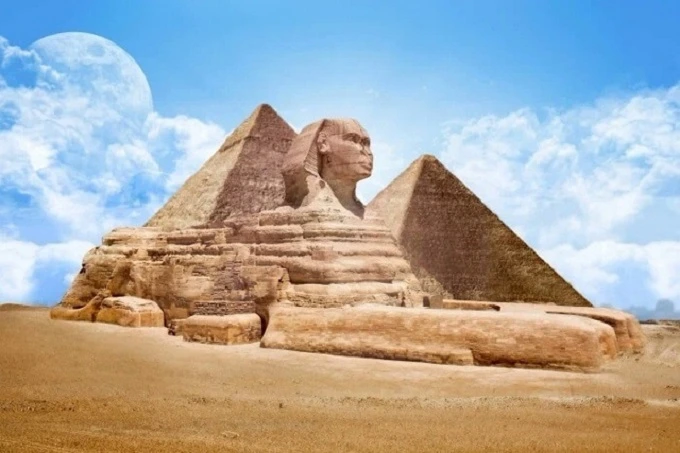Probably, the Great Sphinx of Giza is not only the oldest but also the most famous monument in the world. But can we say that we know everything about him? Alas, even historians and archaeologists are arguing whether this mega-sculpture is just a sculpture or does it conceals many more secrets?
What do we know about the Sphinx of Giza? The fact that its length is 73 meters, and its height is 21. We also know that this priceless monument of antiquity was discovered by the participants of the expedition led by Giovanni Baptista Caviglia back in 1817. Since then, archaeologists have begun to investigate the figure, many books have been written about it, dissertations have been defended, etc. However, even now, after more than 200 years, representatives of science believe that the main discoveries concerning the Sphinx in Giza are still ahead.
Well, for example: historians Jerry Cannon and Malcolm Hutton had suspicions about the existence of a second sphinx after studying images of sphinxes in ancient Egyptian art, which often depict two – one man and one woman.
Historians believe that initially, there were two sphinxes on the site of Giza, which guarded a complex maze of underground temples and tunnels, which once again confirms the stories about a complex network of communications under the gigantic monument.
According to historians, the ancient Egyptians believed that at sunset, the sun traveled through a tunnel inside the Earth, and dawn came when the sun rose after leaving the other end of the tunnel, guarded on both sides by a deity depicted as two lions located at the ends of the tunnel, but looking in different directions.
Although the possibility of the existence of a second female sphinx is not some new theory, Cannon and Hutton believe that they could find the place where he has been buried for many thousands of years. Historians believe that the second Sphinx is located on the second mound next to the male Sphinx standing guard in front of one of the Great Pyramids.
Furthermore, the well-known Egyptologist John Anthony West also draws rather incredible conclusions, saying that the Sphinx was so badly damaged by erosion due to being in a humid environment, but this place has been a desert for at least 9,000 years, and there simply cannot be such heavy and prolonged rains here! Does this mean that the information about the colossal construction of the Sphinx by Khafra 2500 years BC is not true? And the Sphinx is at least 10,000 years old, and its construction dates back to the times when the climate of Egypt was mild and humid, with a lot of precipitation, which caused significant erosion even then.
Here is a photo taken back in the XIX century from a balloon. It shows that the huge sculpture is still partially covered with sand. And when scientists found the statue, it was buried almost completely. But what is on the head of the Sphinx? A huge hole! Why it is still unknown. The monument has undergone a series of restorations, as a result of which its appearance has changed significantly.
How many generations of modern people have seen “their” Sphinx? At first, only the head stuck out of the sand. The sculpture was completely excavated only in 1925. Then excavations, restorations, and research began. Every time some new information appeared, scientists guessed something and built their theories, sometimes contradicting the “unambiguous” conclusions of their colleagues.
For example, researchers Graham Hancock and Mark Lehner believe that the Sphinx is part of a system that also includes the Egyptian pyramids, the Giza plateau itself and… the constellations of Orion and Leo.
There is a version according to which a large repository of ancient texts – books and papyri – is located under the Sphinx. Supposedly, by finding these documents and reading them, we will be able to understand what the origins of our civilization are, and then scientists will learn about the real history of mankind. Or maybe the secrets of the universe will be comprehended, and perhaps the secret of Atlantis is hidden there. Why not? Until the ancient repository is found, you can fantasize.
However, a series of riddles begin, here again, connected not so much with ancient times as with modernity. It turns out that archaeologists’ access to the Sphinx is limited. Graham Hancock and Robert Buvel, who published a book about the secrets of the Sphinx, claim that the governments of Egypt and the United States deliberately blocked excavations under the giant sculpture. Either they are afraid that scientists will find something so important there that it can completely turn our understanding of the world around us, or such a discovery has already been made but is classified?
It is strange that representatives of science are still arguing about whether galleries and rooms are cut down inside the Sphinx or whether it is an integral block of stone. A long time ago, Charles Thompson, who examined the figure, reported that in the upper part of the back of the Sphinx, there is a hole leading into the internal cavities. It would seem that it is easier to confirm or refute this information with modern technologies. But no one ever did.
The rectangular entrance to the sculpture is mentioned by travelers who visited Giza before the Sphinx began to be restored. You can find old photos showing a large crack above the hips. Some scientists suggest that there should be an entrance to the burial chamber.
When scientists talk about prohibitions and obstacles on the part of the Egyptian authorities, they recall how, for “reasons of state security,” the work of archaeologists from Belgium was stopped, who discovered, in 2008 an underground labyrinth and a huge temple consisting of three thousand rooms. If they did this to the temple, then why can’t they hide information about the Sphinx?
